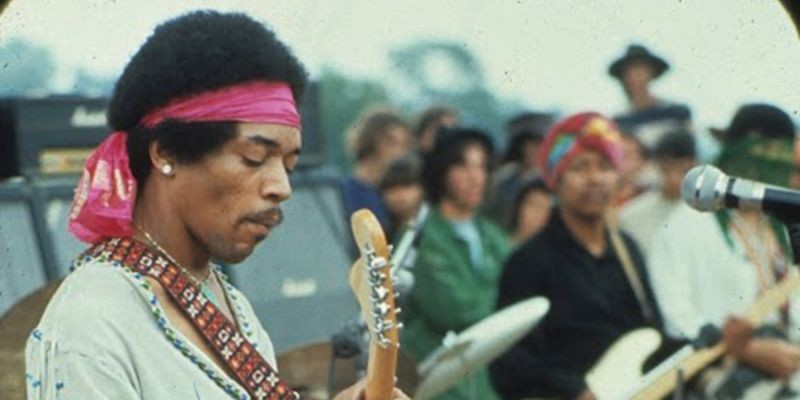
August 18: Jimi Hendrix at Woodstock 1969
By 1969, Hendrix was the world’s highest-paid rock musician. In August, he headlined the Woodstock Music and Art Fair that included many of the most popular bands of the time. For the concert, he added rhythm guitarist Larry Lee and conga players Juma Sultan and Jerry Velez. The band rehearsed for less than two weeks before the performance, and according to Mitchell, they never connected musically. Before arriving at the engagement, he heard reports that the size of the audience had grown to epic proportions, which gave him cause for concern as he did not enjoy performing for large crowds. He was an important draw for the event, and although he accepted substantially less money for the appearance than his usual fee he was the festival’s highest-paid performer. As his scheduled time slot of midnight on Sunday drew closer, he indicated that he preferred to wait and close the show in the morning; the band took the stage around 8:00 a.m. on Monday.
By the time of their set, Hendrix had been awake for more than three days. The audience, which peaked at an estimated 400,000 people, was now reduced to 30–40,000, many of whom had waited to catch a glimpse of Hendrix before leaving during his performance. The festival MC, Chip Monck, introduced the group as the Jimi Hendrix Experience, but Hendrix clarified: “We decided to change the whole thing around and call it Gypsy Sun and Rainbows. For short, it’s nothin’ but a Band of Gypsys”.

Hendrix’s performance featured a rendition of the U.S. national anthem, “The Star-Spangled Banner”, during which he used copious amounts of amplifier feedback, distortion, and sustain to replicate the sounds made by rockets and bombs. Although contemporary political pundits described his interpretation as a statement against the Vietnam War, three weeks later Hendrix explained its meaning: “We’re all Americans … it was like ‘Go America!’… We play it the way the air is in America today. The air is slightly static, see”.It was not the first time he played the national anthem, he had done it nearly 30 times before (and he did it almost 20 times after Woodstock).

However, it became immortalized in the 1970 documentary film, Woodstock, his guitar-driven version would become part of the sixties Zeitgeist.Pop critic Al Aronowitz of The New York Post wrote: “It was the most electrifying moment of Woodstock, and it was probably the single greatest moment of the sixties.” Images of the performance showing Hendrix wearing a blue-beaded white leather jacket with fringe, a red head-scarf, and blue jeans are widely regarded as iconic pictures that capture a defining moment of the era.
Jimi Hendrix Live at Woodstock – An Inside look (short but sweet documentary):
He played “Hey Joe” during the encore, concluding the 3½-day festival. Upon leaving the stage, he collapsed from exhaustion. In 2011, the editors of Guitar World placed his rendition of “The Star-Spangled Banner” at Woodstock at number one in their list of his 100 greatest performances.
This is the original film of the concert released (a bit over 50 minutes long), in 2005 a longer version with 3 more songs and the correct running order (but even on that release there are 2 songs missing):
Several live albums have been released posthumously from Hendrix’s set (or parts of the set).
Jimi Hendrix – guitar, vocals
Billy Cox – bass
Larry Lee – rhythm guitar, vocals
Mitch Mitchell – drums
Juma Sultan – congas
Gerardo “Jerry” Velez – congas
Complete Set-list:
Message to Love
Getting My Heart Back Together Again > Hear My Train a-Comin’
Spanish Castle Magic
Red House
Mastermind
Lover Man
Foxy Lady
Beginning > Jam Back at the House
Izabella
Gypsy Woman
Fire
Voodoo Child (Slight Return)
Stepping Stone
Star Spangled Banner
Purple Haze
Woodstock Improvisation
Villanova Junction
Hey Joe
– Hallgeir
